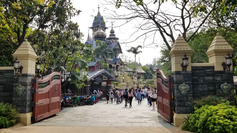
Mystic Point is the setting of Mystic Point and Mystic Manor in Hong Kong Disneyland.
Description[]
Mystic Point is a harbour port in Papua New Guinea owned by British aristocrat Lord Henry Mystic. The colony is built in a dense, potentially supernatural rainforest.
Points of interest[]
- Archive Shop:
- Explorers Club Restaurant: Established by Lord Henry Mystic on the June 12 of 1908, this was a restaurant for the explorers of Mystic Point. The establishment was decorated with objects from Lord Mystic's collection.
- Garden of Wonders:
- Mystic Manor:
- Mystic Point Freight Depot:
Wildlife[]
Fauna[]
- Giant Spiders: Mystic Point is home to abnormally large spiders, significantly larger larger than the Goliath Birdeaters which are the largest spiders known to still be living. Also uniquely, these spiders spin webs to catch their prey which most large spiders (such as the Goliath Birdeater) do not do, rather using their webs to make burrows where they will drag their prey to feed.
- Monkeys: Mystic Point seems to be home to small monkeys, possible of the Capuchin species or a relative of them. This is unique as there are no native species of monkey found within Papua New Guinea. It is possible that monkeys are not native to Mystic Point and Albert got there by other means, but as much is unknown.
History[]
Background[]
Lord Henry Mystic visited the land which would become Mystic Point around the late 1870s/early 1880s. On this expedition, he happened upon a young monkey caught in a spider's web. Mystic saved the monkey and encaged the spider before taking the monkey in as his pet, "Albert". Lord Henry Mystic and Albert would travel the world together, claiming artifacts from across the globe to add to Lord Henry Mystic's personal collection.
Mystic and Albert returned to the jungles of New Guinea in 1896 with Mystic proceeding to take the jungle as his own and colonize it into, "Mystic Point". Mystic Point would be a meeting-place for Lord Henry Mystic's contemporaries along with his nephews James and Edward Mystic. The Lord's nephews aided Lord Mystic in constructing the victorian estate of Mystic Manor where Lord Henry kept his private-collection of 7000 artifacts. Mystic Point was completed in the year 1896.
In 1908, Lord Henry Mystic began running tours within Mystic Manor using his inventions, the Magneto-Electric Carriages. Also in 1908, Mystic opened up the, "Explorers Club Restaurant" to host his contemporary explorers. By around 1936, Mystic Point hosted the Adventure Trading Company, a colonial trading company of which Lord Henry was a member. By 1938, the point also hosted one Dr. Kon Chunosuke, an entomologist from the Society of Explorers and Adventurers of which Mystic was also a member.
Appearances[]
Adventure Trading Company[]
Mystic Point was briefly mentioned in the Daily Gnus newspaper as having been a previous stop for the Adventure Trading Company before their arrival in Adventureland around 1936.
Jungle Cruise[]
Crates from Mystic Point belonging to Dr. Kon Chunosuke of S.E.A. are located in the queue for Disneyland's Jungle Cruise. They used to be located in the queue for Walt Disney World's Jungle Cruise but were removed before refurbishments were complete. Dr. Leonard Moss' journal has a note to contact the Mystic Archive for assistance in studying his carnivorous plant. In Alberta Falls' office, there is a Mystic Point post-card and message to her on a desk, asking about her time in the colony.
Mystic Point[]
Mystic Point is the titular setting of this land in Hong Kong Disneyland.
Oceaneer Lab[]
There is a portrait of Lord Henry Mystic and Albert outside of Mystic Manor aboard the R.V. Oceaneer Lab.
Skipper Canteen[]
In the library of this restaurant are books by Lord Henry Mystic titled Treasures of the Manor and A Manor of Fact and Mysteries of Mystic Manor by Yuen.
Trader Sam's Enchanted Tiki Bar[]
The menu description for these bars mentions how the Jungle Cruise character Trader Sam visited Mystic Point while studying drink recipes.
Trivia[]
- New Guinea is a location that is historically affiliated with gross extents of British and German colonialism. Most notably is Terra Nullius, a form of racist propaganda used in Oceania and New Guinea in-particular where European colonists claimed the land was uninhabited due to a lack of Western agriculture (agricultural practices which traditionally would not function in said regions).



